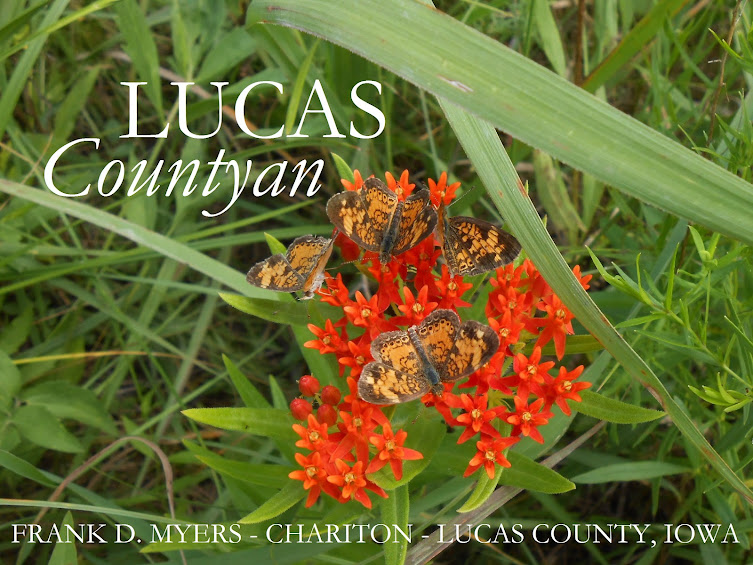Jan, Martha, Mary Ellen, Faye and Gordon around Emaline Greenlee's tombstone.
The first trick is to locate Greenlee Cemetery, out northwest of Corydon in Wayne County’s Benton Township. The second, figuring out how to reach it; and the final challenge --- getting there once you’ve figured everything else out. Don’t try it on a muddy day, or in a vehicle with too low a profile --- chances are you can make it if it's dry, but then again, maybe not.
When you finally reach Greenlee, you’ll discover a gently restored little graveyard on the wooded east slope of South Chariton River valley, immaculately maintained by Benton Township trustees. Pretty, peaceful, looking much as it might have 100 years ago.
I’m guessing --- but could be wrong --- that this was a principal burying place for residents of old Peoria, a ghost town platted about a mile east-northeast during 1853 in section 15 (the cemetery is in section 16). About 1880, Peoria was renamed Bentonville --- after the trains came. And then it pretty much vanished, too close to Corydon to survive.
The name “Greenlee” honors Sylvester Greenlee and his wife, Esther (Barnett) Greenlee, members of that tribe of Mason County, (West) Virginians, who descended on Wayne County during the 1850s --- including my great-great-grandparents, their immediate and extended families.
Sylvester Greenlee entered land in Section 15 during 1851, then settled his family in a log cabin there on April 1, 1852.
Among the Bott graves at the foot of the cemetery. The newer granite stone identifies three family members whose graves are marked by smaller headstones inscribed "Father," "Mother" and "Stepmother." They are George Bott (died 1865 at age 64), Caroline Bott (died 1854 at age 54) and Julia Bott (died 1865, age not given).
The earliest marked burial in the cemetery is that of the Greenlees’ daughter, Emaline, who died Aug. 15, 1853, age 5 months and 28 days. A son, Robert L., died during 1858 before reaching 5 months, and is buried beside Emaline. In adjacent graves are two children of Sylvester’s and Esther’s son and daughter-in-law, Levi Thompson and Sophia (Everett) Greenlee.
It’s logical to guess that the cemetery was founded on Greenlee land, but digging in land records would be necessary to prove it. Sylvester’s and Esther’s daughter and son-in-law, Martha and H.T. Peck, also rest here, but the Sylvester Greenlees are buried at Promise City, where they moved in 1879, and the Levi Greenlees, perhaps in Webster County.
Little Emaline Greenlee was joined on this pretty hillside three months after her death by James Lunsford, who died Nov. 7, 1853, at age 37. The last marked burial in Greenlee was made during 1942.
Saturday’s visit to Greenlee was part of Mary Ellen’s birthday observance, following lunch. She had never been there, and wanted to see it --- the closest cemetery to her farm --- and wanted to take friends along. She’d also done her homework, so we knew how to get there.
It’s a little complicated. Drive a half mile west of where old Peoria/Bentonville used to be, then turn south on a road that’s now dead-end because the county supervisors allowed a massive pond to be built across its southern end.
When you come to the first barn, turn west into the farm driveway along its south side, drive on through the gate, cross a cornfield, drive through a wooded waterway, then up over the hill of a second cornfield --- and there you are at the cemetery gate. There is no sign. There is no gravel on this path, which leads about half a mile in from the road. You’re just kind of on your own.
Six of us made the trek --- Mary Ellen, Jan and I, who live in this neck of the woods; Gordon and Faye, from Iowa City; and Martha, who lives out west of Knoxville and is one of Iowa’s leading prairie people.
We spent a lot of time just looking, walking from grave to grave and imagining things about the people buried here. Martha patrolled the perimeter, looking for signs of prairie plants and finding few survivals --- all of these hills have been farmed and grazed.
I found a challenge at Greenlee for the Fox cousins who were here a couple of weeks ago. Here is the tombstone of Lizzie, "beloved wife of I.E. Fox, born Oct. 27, 1875, died May 8, 1894." We guessed that Lizzie was a daughter of P.L and M.E. Robinson, since she is buried next to their son, Willett, who died during 1887 at age 21. But who was I.E.?
I liked the way the cemetery has been cared for. Only one tombstone had shattered; the rest had been secured upright when necessary in new footings years ago. The old limestone and marble tablet stones had not been subjected to aggressive cleaning, so their surfaces were intact. And the old fencerows were there, too, intended for the most part to keep roaming livestock out.
Driving in, I kept thinking, “wow, they should do something about this road.” Now, I’m not so sure. In may be that remoteness is Greenlee’s best insurance.
When you finally reach Greenlee, you’ll discover a gently restored little graveyard on the wooded east slope of South Chariton River valley, immaculately maintained by Benton Township trustees. Pretty, peaceful, looking much as it might have 100 years ago.
Looking up Greenlee's slope to the east.
I’m guessing --- but could be wrong --- that this was a principal burying place for residents of old Peoria, a ghost town platted about a mile east-northeast during 1853 in section 15 (the cemetery is in section 16). About 1880, Peoria was renamed Bentonville --- after the trains came. And then it pretty much vanished, too close to Corydon to survive.
The name “Greenlee” honors Sylvester Greenlee and his wife, Esther (Barnett) Greenlee, members of that tribe of Mason County, (West) Virginians, who descended on Wayne County during the 1850s --- including my great-great-grandparents, their immediate and extended families.
Sylvester Greenlee entered land in Section 15 during 1851, then settled his family in a log cabin there on April 1, 1852.
Among the Bott graves at the foot of the cemetery. The newer granite stone identifies three family members whose graves are marked by smaller headstones inscribed "Father," "Mother" and "Stepmother." They are George Bott (died 1865 at age 64), Caroline Bott (died 1854 at age 54) and Julia Bott (died 1865, age not given).
The earliest marked burial in the cemetery is that of the Greenlees’ daughter, Emaline, who died Aug. 15, 1853, age 5 months and 28 days. A son, Robert L., died during 1858 before reaching 5 months, and is buried beside Emaline. In adjacent graves are two children of Sylvester’s and Esther’s son and daughter-in-law, Levi Thompson and Sophia (Everett) Greenlee.
It’s logical to guess that the cemetery was founded on Greenlee land, but digging in land records would be necessary to prove it. Sylvester’s and Esther’s daughter and son-in-law, Martha and H.T. Peck, also rest here, but the Sylvester Greenlees are buried at Promise City, where they moved in 1879, and the Levi Greenlees, perhaps in Webster County.
Little Emaline Greenlee was joined on this pretty hillside three months after her death by James Lunsford, who died Nov. 7, 1853, at age 37. The last marked burial in Greenlee was made during 1942.
+++
Saturday’s visit to Greenlee was part of Mary Ellen’s birthday observance, following lunch. She had never been there, and wanted to see it --- the closest cemetery to her farm --- and wanted to take friends along. She’d also done her homework, so we knew how to get there.
It’s a little complicated. Drive a half mile west of where old Peoria/Bentonville used to be, then turn south on a road that’s now dead-end because the county supervisors allowed a massive pond to be built across its southern end.
When you come to the first barn, turn west into the farm driveway along its south side, drive on through the gate, cross a cornfield, drive through a wooded waterway, then up over the hill of a second cornfield --- and there you are at the cemetery gate. There is no sign. There is no gravel on this path, which leads about half a mile in from the road. You’re just kind of on your own.
Six of us made the trek --- Mary Ellen, Jan and I, who live in this neck of the woods; Gordon and Faye, from Iowa City; and Martha, who lives out west of Knoxville and is one of Iowa’s leading prairie people.
We spent a lot of time just looking, walking from grave to grave and imagining things about the people buried here. Martha patrolled the perimeter, looking for signs of prairie plants and finding few survivals --- all of these hills have been farmed and grazed.
I found a challenge at Greenlee for the Fox cousins who were here a couple of weeks ago. Here is the tombstone of Lizzie, "beloved wife of I.E. Fox, born Oct. 27, 1875, died May 8, 1894." We guessed that Lizzie was a daughter of P.L and M.E. Robinson, since she is buried next to their son, Willett, who died during 1887 at age 21. But who was I.E.?
I liked the way the cemetery has been cared for. Only one tombstone had shattered; the rest had been secured upright when necessary in new footings years ago. The old limestone and marble tablet stones had not been subjected to aggressive cleaning, so their surfaces were intact. And the old fencerows were there, too, intended for the most part to keep roaming livestock out.
Driving in, I kept thinking, “wow, they should do something about this road.” Now, I’m not so sure. In may be that remoteness is Greenlee’s best insurance.
Looking east from Greenlee's gate to the final leg of the half-mile "lane" that leads in from the road.































































